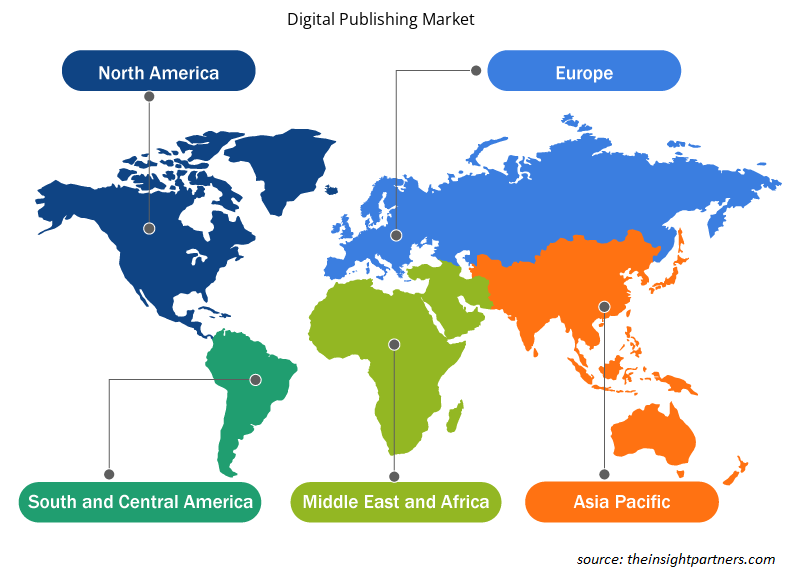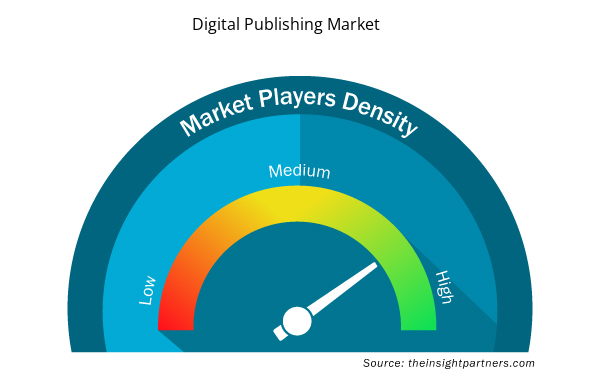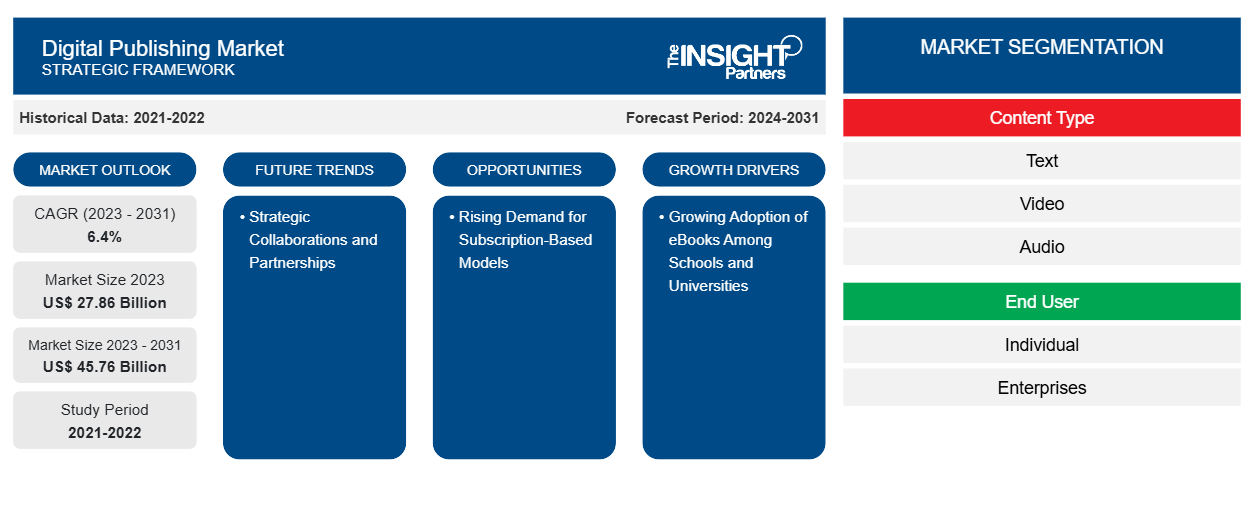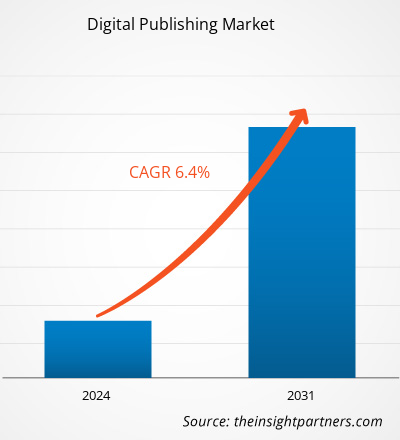من المتوقع أن يصل حجم سوق النشر الرقمي إلى 45.76 مليار دولار أمريكي بحلول عام 2031 من 27.86 مليار دولار أمريكي في عام 2023. ومن المتوقع أن يسجل السوق معدل نمو سنوي مركب بنسبة 6.4٪ خلال الفترة 2023-2031. ومن المرجح أن تظل التعاونات والشراكات الاستراتيجية اتجاهًا رئيسيًا في السوق.
تحليل سوق النشر الرقمي
إن النشر الرقمي يحل بسرعة محل طريقة النشر المطبوع التقليدية. وعلاوة على ذلك، فقد أدى جائحة كوفيد-19 أيضًا إلى زيادة الوسائط الرقمية جنبًا إلى جنب مع عوامل أخرى تعزز نمو النشر الرقمي. يعمل الناشرون بسرعة على زيادة التوزيع وتوسيع مصادر إيراداتهم الحالية من خلال اختيار النشر الرقمي. بالإضافة إلى العوامل المذكورة أعلاه، هناك العديد من ميزات النشر الرقمي الجديدة التي من المتوقع أن تؤثر على نمو النشر الرقمي في السنوات الست إلى السبع القادمة. على سبيل المثال، فإن التوثيق وبساطة تنفيذ المنتج، بالإضافة إلى الأداء وتجربة المستخدم التي يمكن الوصول إليها بسرعة وسهولة، تدفع الحاجة إلى المحتوى الأصلي أو المحتوى الذي ينشئه المستخدم للاحتفاظ بالمستخدمين، وتحقيق الدخل من المحتوى، ودمج التجارة الإلكترونية.
نظرة عامة على سوق النشر الرقمي
يتضمن النشر الرقمي، المعروف بالنشر الإلكتروني أو عبر الإنترنت، نشر محتوى مختلف عبر الإنترنت مثل الدوريات والمجلات والصحف والكتب الإلكترونية. من خلال اتباع هذه العملية، يمكن لأي شركة أو كيان نشر تحويل المستندات والبيانات الورقية إلى تنسيق رقمي، يمكن الوصول إليه عبر الإنترنت وتنزيله وتحريره وطباعته أو مشاركته وفقًا لتقدير المستخدمين.
قم بتخصيص هذا التقرير ليناسب متطلباتك
ستحصل على تخصيص لأي تقرير - مجانًا - بما في ذلك أجزاء من هذا التقرير، أو تحليل على مستوى الدولة، وحزمة بيانات Excel، بالإضافة إلى الاستفادة من العروض والخصومات الرائعة للشركات الناشئة والجامعات
- احصل على أهم اتجاهات السوق الرئيسية لهذا التقرير.ستتضمن هذه العينة المجانية تحليلاً للبيانات، بدءًا من اتجاهات السوق وحتى التقديرات والتوقعات.
محركات وفرص سوق النشر الرقمي
تزايد استخدام الكتب الإلكترونية بين المدارس والجامعات لصالح السوق
تدعم الكتب الإلكترونية المؤسسات التعليمية في تحقيق ثلاثة أهداف استراتيجية رئيسية: تعزيز تجربة الطلاب والإنجازات الأكاديمية في بيئة أكثر تنافسية، وتعزيز الابتكار في التدريس والتعلم والبحث، والمساعدة في الاستخدام الأمثل للموارد المكانية والبشرية. بالنسبة للجامعات ومكتباتها، كانت هناك مشكلة قائمة منذ فترة طويلة تتمثل في ضمان توافر الكتب المهمة في الوقت المناسب، وكانت الشكوى الأساسية في استطلاعات الطلاب غالبًا هي العدد غير الكافي من النسخ. يمكن للطلاب الوصول بسهولة إلى الكتب الإلكترونية في أي وقت ومن أي مكان، مما يجعلها خيارًا مناسبًا يتماشى مع توقعاتهم بطريقة أكثر كفاءة.
علاوة على ذلك، فإن التقدم المتزايد في التعليم والتدريب والاستكشاف يؤثر على الإقبال العالمي على النشر الرقمي. على سبيل المثال، تقدم جامعة ليستر درجة الماجستير في الأمن والصراع والتنمية الدولية من خلال التعلم عبر الإنترنت. يقدم قسم علم الإجرام برنامجًا مصممًا خصيصًا للأفراد في قطاع التنمية الدولية أو الطامحين إلى العمل فيه. يمكن للطلاب في هذا البرنامج العمل في أماكن عسكرية أو مناطق نائية أو كقوات حفظ سلام، بعيدًا عن بيئة الفصول الدراسية النموذجية. يتلقى كل طالب جهاز iPad يحتوي على مواد الدورة والكتب الإلكترونية وتطبيق الدورة للوصول. يمكن للطلاب الوصول إلى هذه الكتب الإلكترونية وقراءتها حتى عندما يفتقر مكان عملهم إلى اتصال إنترنت موثوق به، والذي قد يكون غالبًا غير متاح أو غير موثوق به. إن الاستخدام المتزايد للكتب الإلكترونية في المؤسسات التعليمية يدفع توسع صناعة النشر الرقمي في جميع أنحاء العالم.
ارتفاع الطلب على النماذج القائمة على الاشتراك
تتطلب البيئة الإلكترونية المتغيرة المرونة، مما يدفع الناشرين إلى تنويع مصادر دخلهم. وهم يبحثون عن طرق جديدة لضمان الاستقرار المالي، والتوسع خارج نماذج الإعلان والاشتراك المعتادة. وتُرى هذه الاستراتيجية الجديدة بطرق مختلفة: من خلال شراكات المحتوى المدعوم، حيث تعمل العلامات التجارية معًا على محتوى ذي صلة، أو التسويق بالعمولة، حيث يكسب الناشرون المال من خلال تسويق المنتجات أو الخدمات وكسب العمولات. كما يوفر تنظيم الأحداث أو إنشاء الدورات التدريبية عبر الإنترنت طرقًا مباشرة للتفاعل مع القراء. إنه يخلق رابطًا أعمق وإمكانية الحصول على المزيد من الدخل. يعيد الناشرون تقييم أساليبهم الحالية، بهدف تخصيص وتلبية احتياجات المستخدمين الأفراد. تتيح المدفوعات الصغيرة، التي أصبحت شائعة بشكل متزايد، للقراء دفع رسوم صغيرة مقابل مقالات فردية بدلاً من الالتزام بخدمات الاشتراك الكاملة، مما يوفر المزيد من المرونة ويلبي عادات الاستهلاك المتنوعة.
تقرير تحليل تجزئة سوق النشر الرقمي
إن القطاعات الرئيسية التي ساهمت في استنتاج تحليل سوق النشر الرقمي هي نوع المحتوى والمستخدم النهائي.
- بناءً على نوع المحتوى، يتم تقسيم السوق إلى نصوص وفيديو وصوت. احتل قطاع الفيديو حصة سوقية كبيرة في عام 2023.
- من حيث المستخدم النهائي، ينقسم السوق إلى أفراد ومؤسسات. وقد استحوذ القطاع الفردي على حصة كبيرة من السوق في عام 2023.
تحليل حصة سوق النشر الرقمي حسب المنطقة الجغرافية
ينقسم النطاق الجغرافي لتقرير سوق النشر الرقمي بشكل أساسي إلى خمس مناطق: أمريكا الشمالية، ومنطقة آسيا والمحيط الهادئ، وأوروبا، والشرق الأوسط وأفريقيا، وأمريكا الجنوبية والوسطى.
من المتوقع أن تستحوذ أمريكا الشمالية على حصة كبيرة في سوق النشر الرقمي في عام 2023. والزيادة المتوقعة في الطلب على سوق النشر الرقمي في هذه المنطقة مدفوعة بالحاجة المتزايدة إلى منشورات رقمية محسنة. وتشارك شركات رائدة في السوق مثل Adobe Inc. وApple Inc. وAmazon.com Inc. وAlphabet Inc. وغيرها في شراكات وعمليات استحواذ وتطوير منتجات وتحسينات جديدة، مما يدفع نمو السوق في المنطقة. ومن الأمثلة على ذلك عندما كشفت Comcast Inc. عن حل جديد في مارس 2021 للاتصال بإدارة الحملات الإعلانية المركزية للتلفزيون.
رؤى إقليمية حول سوق النشر الرقمي
لقد قام المحللون في Insight Partners بشرح الاتجاهات والعوامل الإقليمية المؤثرة على سوق النشر الرقمي طوال فترة التوقعات بشكل شامل. يناقش هذا القسم أيضًا قطاعات سوق النشر الرقمي والجغرافيا في جميع أنحاء أمريكا الشمالية وأوروبا ومنطقة آسيا والمحيط الهادئ والشرق الأوسط وأفريقيا وأمريكا الجنوبية والوسطى.

- احصل على البيانات الإقليمية المحددة لسوق النشر الرقمي
نطاق تقرير سوق النشر الرقمي
| سمة التقرير | تفاصيل |
|---|---|
| حجم السوق في عام 2023 | 27.86 مليار دولار أمريكي |
| حجم السوق بحلول عام 2031 | 45.76 مليار دولار أمريكي |
| معدل النمو السنوي المركب العالمي (2023 - 2031) | 6.4% |
| البيانات التاريخية | 2021-2022 |
| فترة التنبؤ | 2024-2031 |
| القطاعات المغطاة | حسب نوع المحتوى
|
| المناطق والدول المغطاة | أمريكا الشمالية
|
| قادة السوق وملفات تعريف الشركات الرئيسية |
|
كثافة اللاعبين في سوق النشر الرقمي: فهم تأثيرها على ديناميكيات الأعمال
يشهد سوق النشر الرقمي نموًا سريعًا، مدفوعًا بالطلب المتزايد من المستخدم النهائي بسبب عوامل مثل تفضيلات المستهلكين المتطورة والتقدم التكنولوجي والوعي المتزايد بفوائد المنتج. ومع ارتفاع الطلب، تعمل الشركات على توسيع عروضها والابتكار لتلبية احتياجات المستهلكين والاستفادة من الاتجاهات الناشئة، مما يؤدي إلى زيادة نمو السوق.
تشير كثافة اللاعبين في السوق إلى توزيع الشركات أو المؤسسات العاملة في سوق أو صناعة معينة. وهي تشير إلى عدد المنافسين (اللاعبين في السوق) الموجودين في مساحة سوق معينة نسبة إلى حجمها أو قيمتها السوقية الإجمالية.
الشركات الرئيسية العاملة في سوق النشر الرقمي هي:
- هوريكس ديجيتال
- فيجوا
- فيتالسورس تكنولوجيز
- تقنيات إكسلسوفت
- شركة إمبيلسيس
- إيسوو
إخلاء المسؤولية : الشركات المذكورة أعلاه ليست مرتبة بأي ترتيب معين.

- احصل على نظرة عامة على أهم اللاعبين الرئيسيين في سوق النشر الرقمي
أخبار سوق النشر الرقمي والتطورات الأخيرة
يتم تقييم سوق النشر الرقمي من خلال جمع البيانات النوعية والكمية بعد البحث الأولي والثانوي، والتي تتضمن منشورات الشركات المهمة وبيانات الجمعيات وقواعد البيانات. فيما يلي بعض التطورات في سوق النشر الرقمي:
- تقدم FlipHTML5 أداة إنشاء الكتب الإلكترونية المبتكرة التي تعمل بالذكاء الاصطناعي، والتي تعمل على إحداث ثورة في صناعة النشر الرقمي. تعمل هذه الأداة المتقدمة على تبسيط إنشاء الكتب الإلكترونية، مما يتيح للمستخدمين إنتاج كتب إلكترونية احترافية وتفاعلية بسلاسة.
(المصدر: PR UNDERGROUND، بيان صحفي، يونيو 2024)
- في خطوة جريئة لتعزيز قدرات الناشرين والمبدعين الرقميين، أطلقت شركة Ezoic للتو برنامج Enterprise الذي طال انتظاره. تم تصميم هذا البرنامج الشامل من الخدمات والميزات خصيصًا للمبدعين على مستوى المؤسسات، وهو يمثل توسعًا كبيرًا في عروض Ezoic، حيث يوفر حلولاً مخصصة لتلبية الاحتياجات الفريدة للناشرين والمبدعين الرقميين على نطاق واسع.
(المصدر: موقع شركة Ezoic الإلكتروني، مارس 2023)
تغطية تقرير سوق النشر الرقمي والمنتجات النهائية
يوفر تقرير "حجم سوق النشر الرقمي والتوقعات (2021-2031)" تحليلاً مفصلاً للسوق يغطي المجالات التالية:
- حجم سوق النشر الرقمي وتوقعاته على المستويات العالمية والإقليمية والوطنية لجميع قطاعات السوق الرئيسية التي يغطيها النطاق
- اتجاهات سوق النشر الرقمي بالإضافة إلى ديناميكيات السوق مثل المحركات والقيود والفرص الرئيسية
- تحليل مفصل لقوى PEST/Porter الخمس وSWOT
- تحليل سوق النشر الرقمي الذي يغطي اتجاهات السوق الرئيسية والإطار العالمي والإقليمي والجهات الفاعلة الرئيسية واللوائح والتطورات الأخيرة في السوق
- تحليل المشهد الصناعي والمنافسة الذي يغطي تركيز السوق، وتحليل خريطة الحرارة، واللاعبين البارزين، والتطورات الأخيرة لسوق النشر الرقمي
- ملفات تعريف الشركة التفصيلية
- التحليل التاريخي (سنتان)، السنة الأساسية، التوقعات (7 سنوات) مع معدل النمو السنوي المركب
- تحليل PEST و SWOT
- حجم السوق والقيمة / الحجم - عالميًا وإقليميًا وقطريًا
- الصناعة والمنافسة
- مجموعة بيانات Excel


- Wind Turbine Composites Market
- Nuclear Decommissioning Services Market
- Industrial Valves Market
- Space Situational Awareness (SSA) Market
- Data Annotation Tools Market
- Clinical Trial Supplies Market
- Lymphedema Treatment Market
- Educational Furniture Market
- Medical Enzyme Technology Market
- Aircraft Landing Gear Market

Report Coverage
Revenue forecast, Company Analysis, Industry landscape, Growth factors, and Trends

Segment Covered
This text is related
to segments covered.

Regional Scope
North America, Europe, Asia Pacific, Middle East & Africa, South & Central America

Country Scope
This text is related
to country scope.
الأسئلة الشائعة
The market is anticipated to record a CAGR of 6.4% during 2023–2031.
The market is expected to reach a value of US$ 45.76 billion by 2031.
HurixDigital, Vijua, VitalSource Technologies, Excelsoft Technologies, Impelsys Inc., Issuu, Lulu Press, Inc., Kortext, Magic EdTech, and RedShelf are major players in the market.
Strategic collaborations and partnerships a key trend in the market.
Growing adoption of ebooks among schools & universities and the impact of digital generation are driving the market.
Trends and growth analysis reports related to Technology, Media and Telecommunications : READ MORE..
The Insight Partners performs research in 4 major stages: Data Collection & Secondary Research, Primary Research, Data Analysis and Data Triangulation & Final Review.
- Data Collection and Secondary Research:
As a market research and consulting firm operating from a decade, we have published and advised several client across the globe. First step for any study will start with an assessment of currently available data and insights from existing reports. Further, historical and current market information is collected from Investor Presentations, Annual Reports, SEC Filings, etc., and other information related to company’s performance and market positioning are gathered from Paid Databases (Factiva, Hoovers, and Reuters) and various other publications available in public domain.
Several associations trade associates, technical forums, institutes, societies and organization are accessed to gain technical as well as market related insights through their publications such as research papers, blogs and press releases related to the studies are referred to get cues about the market. Further, white papers, journals, magazines, and other news articles published in last 3 years are scrutinized and analyzed to understand the current market trends.
- Primary Research:
The primarily interview analysis comprise of data obtained from industry participants interview and answers to survey questions gathered by in-house primary team.
For primary research, interviews are conducted with industry experts/CEOs/Marketing Managers/VPs/Subject Matter Experts from both demand and supply side to get a 360-degree view of the market. The primary team conducts several interviews based on the complexity of the markets to understand the various market trends and dynamics which makes research more credible and precise.
A typical research interview fulfils the following functions:
- Provides first-hand information on the market size, market trends, growth trends, competitive landscape, and outlook
- Validates and strengthens in-house secondary research findings
- Develops the analysis team’s expertise and market understanding
Primary research involves email interactions and telephone interviews for each market, category, segment, and sub-segment across geographies. The participants who typically take part in such a process include, but are not limited to:
- Industry participants: VPs, business development managers, market intelligence managers and national sales managers
- Outside experts: Valuation experts, research analysts and key opinion leaders specializing in the electronics and semiconductor industry.
Below is the breakup of our primary respondents by company, designation, and region:

Once we receive the confirmation from primary research sources or primary respondents, we finalize the base year market estimation and forecast the data as per the macroeconomic and microeconomic factors assessed during data collection.
- Data Analysis:
Once data is validated through both secondary as well as primary respondents, we finalize the market estimations by hypothesis formulation and factor analysis at regional and country level.
- Macro-Economic Factor Analysis:
We analyse macroeconomic indicators such the gross domestic product (GDP), increase in the demand for goods and services across industries, technological advancement, regional economic growth, governmental policies, the influence of COVID-19, PEST analysis, and other aspects. This analysis aids in setting benchmarks for various nations/regions and approximating market splits. Additionally, the general trend of the aforementioned components aid in determining the market's development possibilities.
- Country Level Data:
Various factors that are especially aligned to the country are taken into account to determine the market size for a certain area and country, including the presence of vendors, such as headquarters and offices, the country's GDP, demand patterns, and industry growth. To comprehend the market dynamics for the nation, a number of growth variables, inhibitors, application areas, and current market trends are researched. The aforementioned elements aid in determining the country's overall market's growth potential.
- Company Profile:
The “Table of Contents” is formulated by listing and analyzing more than 25 - 30 companies operating in the market ecosystem across geographies. However, we profile only 10 companies as a standard practice in our syndicate reports. These 10 companies comprise leading, emerging, and regional players. Nonetheless, our analysis is not restricted to the 10 listed companies, we also analyze other companies present in the market to develop a holistic view and understand the prevailing trends. The “Company Profiles” section in the report covers key facts, business description, products & services, financial information, SWOT analysis, and key developments. The financial information presented is extracted from the annual reports and official documents of the publicly listed companies. Upon collecting the information for the sections of respective companies, we verify them via various primary sources and then compile the data in respective company profiles. The company level information helps us in deriving the base number as well as in forecasting the market size.
- Developing Base Number:
Aggregation of sales statistics (2020-2022) and macro-economic factor, and other secondary and primary research insights are utilized to arrive at base number and related market shares for 2022. The data gaps are identified in this step and relevant market data is analyzed, collected from paid primary interviews or databases. On finalizing the base year market size, forecasts are developed on the basis of macro-economic, industry and market growth factors and company level analysis.
- Data Triangulation and Final Review:
The market findings and base year market size calculations are validated from supply as well as demand side. Demand side validations are based on macro-economic factor analysis and benchmarks for respective regions and countries. In case of supply side validations, revenues of major companies are estimated (in case not available) based on industry benchmark, approximate number of employees, product portfolio, and primary interviews revenues are gathered. Further revenue from target product/service segment is assessed to avoid overshooting of market statistics. In case of heavy deviations between supply and demand side values, all thes steps are repeated to achieve synchronization.
We follow an iterative model, wherein we share our research findings with Subject Matter Experts (SME’s) and Key Opinion Leaders (KOLs) until consensus view of the market is not formulated – this model negates any drastic deviation in the opinions of experts. Only validated and universally acceptable research findings are quoted in our reports.
We have important check points that we use to validate our research findings – which we call – data triangulation, where we validate the information, we generate from secondary sources with primary interviews and then we re-validate with our internal data bases and Subject matter experts. This comprehensive model enables us to deliver high quality, reliable data in shortest possible time.


 احصل على عينة مجانية لهذا التقرير
احصل على عينة مجانية لهذا التقرير